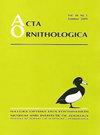Food of Nuthatch Sitta europaea Young in a Primeval Forest: Effects of Varying Food Supply and Age of Nestlings
IF 1.3
4区 生物学
Q3 ORNITHOLOGY
引用次数: 12
Abstract
Information on nestling diet composition is crucial for understanding the variation in birds breeding seasons at both the ultimate and proximate levels. We studied Nuthatch nestling food composition along with availability of its presumed main food resource — folivorous caterpillars — in a primeval forest, free from direct human impact (Bialowieza National Park, Poland), in 1998–2004. Food brought to young during 4281 feeding visits (235 broods) was recorded. Nestlings were fed mostly caterpillars (53% of visits), but winged insects (14%), beetles (11%) and spiders (10%) were also regularly provided. The proportion of caterpillars increased with increasing caterpillar availability (measured by frassfall), with a maximum around the seasonal peaks and a later decline. The proportion of caterpillars in the diet was lower on days when frassfall was low (< 0.1 g/0.25 m2/day), irrespective of the temporal distance from the frass peak, while the proportion of winged insects increased on such days. Above the 0.1 g frassfall threshold, the proportion of caterpillars regularly exceeded 50%, reaching 90% on individual days. As in the majority of years the ‘caterpillars’ remained above the 0.1 g level over long periods, this could account for a comparably small interyear variation in the proportion of caterpillars in the diet, despite nearly tenfold differences in caterpillar abundance across years. ‘Caterpillars’ were brought significantly less often to the smallest, 5-day old, nestlings (52%), than to older ones (64%, 71% and 72% for 10-, 15- and 20-days old young, respectively). Spiders were most often provided to the smallest nestlings.原始森林中幼雏nuthech Sitta europaea的食物:不同食物供应和雏鸟年龄的影响
关于雏鸟饮食组成的信息对于了解鸟类繁殖季节的最终和接近水平的变化至关重要。1998年至2004年,我们在没有直接人类影响的原始森林(波兰比亚洛维耶扎国家公园)中研究了Nutchch筑巢的食物组成及其假定的主要食物资源——食叶毛毛虫的可用性。记录了4281次喂食(235窝)期间给幼崽带来的食物。巢主要由毛毛虫(53%的访问)喂养,但也定期提供有翼昆虫(14%)、甲虫(11%)和蜘蛛(10%)。毛毛虫的比例随着毛毛虫可用性的增加而增加(以frassfall衡量),在季节高峰期达到最大值,随后下降。无论与frass峰值的时间距离如何,在frass下降较低的日子(<0.1 g/0.25 m2/天),毛虫在饮食中的比例较低,而有翼昆虫的比例在这些日子增加。在0.1克frassfall阈值以上,毛毛虫的比例经常超过50%,个别天数达到90%。由于在大多数年份,“毛毛虫”在很长一段时间内都保持在0.1克以上的水平,这可能是毛毛虫在饮食中所占比例的年间变化相对较小的原因,尽管多年来毛毛虫的数量相差近十倍。”最小的、5天大的雏鸟(52%)感染毛毛虫的次数明显少于年长的雏鸟,10天大、15天大和20天大的幼鸟分别为64%、71%和72%。蜘蛛通常被提供给最小的雏鸟。
本文章由计算机程序翻译,如有差异,请以英文原文为准。
求助全文
约1分钟内获得全文
求助全文
来源期刊

Acta Ornithologica
生物-鸟类学
CiteScore
2.10
自引率
0.00%
发文量
14
审稿时长
>12 weeks
期刊介绍:
Publishes scientific papers (original research reports, reviews, short notes, etc.) and announcements from all fields of ornithology. All manuscripts are peer-reviewed.
Established in 1933 as Acta Ornithologica Musei Zoologici Polonici, since 1953 continued under the present title.
Published twice a year by the Natura Optima Dux Foundation under the auspices of the Museum and Institute of Zoology, Polish Academy of Sciences.
 求助内容:
求助内容: 应助结果提醒方式:
应助结果提醒方式:


